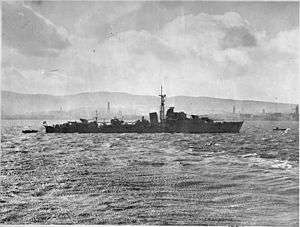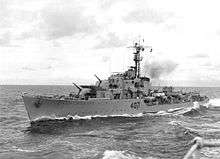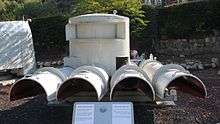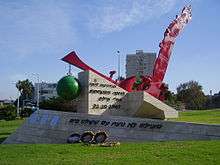HMS Zealous (R39)
 HMS Zealous moored at Gourock, March 1945 | |
| History | |
|---|---|
| Name: | HMS Zealous |
| Ordered: | 12 February 1942 |
| Builder: | Cammell Laird |
| Laid down: | 5 May 1943 |
| Launched: | 28 February 1944 |
| Commissioned: | 9 October 1944 |
| Out of service: | Sold to Israel, 15 July 1955 |
| Name: | INS Eilat |
| Acquired: | 15 July 1955 |
| Commissioned: | July 1956 |
| Fate: | Sunk 21 October 1967 |
| General characteristics | |
| Class and type: | Z-class destroyer |
| Displacement: | 1,710 tons |
| Length: | 362.7 ft (110.6 m) |
| Beam: | 35.7 ft (10.9 m) |
| Propulsion: |
|
| Speed: | 37 knots (69 km/h; 43 mph) |
| Complement: | 186 |
| Armament: |
|
HMS Zealous was a Z-class destroyer of the Royal Navy built in 1944 by Cammell Laird. She served during the Second World War, participating in operations in the North Sea and off the Norwegian coast, before taking part in some of the Arctic convoys. She spent a further ten years in Royal Navy service after the end of the war, before being sold to the Israeli Navy, which operated her as INS Eilat. She saw action during the Suez Crisis in 1956, attacking Egyptian ships and was still active by the outbreak of the Six-Day War in 1967. She was sunk several months after the conflict by missiles launched from several small Egyptian missile boats; this made her the first vessel to be sunk by a missile boat in wartime. It was an important milestone in naval surface warfare, which aroused considerable interest around the world in the development of small manoeuvrable missile boats.
Second World War
Zealous was one of four British destroyers of the Home Fleet that rescued 525 Norwegians, who had been hiding from German patrols in caves on the snow-covered mountains of Sørøya island, Norway for three months. The rescue involved the destroyers on a daring race 60 miles (97 km) behind enemy lines. The Norwegians were safely evacuated to the British port of Gourock.
Zealous made two trips from the UK to Russia as part of the Arctic Convoys taking supplies around Norway to Kola. Under the guidance of Commander R.F. Jessel RN DSO she ran the gauntlet of German U-Boats and aircraft.
On 5 April 1945 she was involved in an attack on a convoy entering the Jøssingfjord on the coast of Norway. One merchant ship was sunk and two were damaged.[1] When the Germans were on the brink of capitulation, the ship was ordered to Copenhagen. There she was mistaken by excited German soldiers as a German destroyer sent to evacuate them.
Service as Eilat

From October 1945 until August 1946 Zealous served in the 4th Destroyer Flotilla as part of the Home Fleet. From 1947 until 1950 she was held in reserve at Devonport. Between 1950 and 1951 she underwent a refit at Cardiff. Between 1953 and 1954 she was held in reserve at Penarth.[2]
In 1955 the UK sold Zealous to Israel, which commissioned her into the Israeli Navy as INS Eilat (after the Israeli southern coastal city of Eilat, replacing the earlier INS Eilat) in July 1956. On the morning of 31 October, in the midst of the Suez Crisis, the Egyptian destroyer Ibrahim el Awal ( an ex-British Hunt class destroyer) shelled Haifa harbor. A counter-attack by the French destroyer Kersaint and by the Israeli Yaffo and Eilat forced the Egyptian destroyer to steam back towards Port Said. It was then also attacked by a pair of IDF/AF Ouragans and a Dakota. The crew of the badly damaged vessel finally capitulated, and the Israelis towed the ship to Haifa; it later became the Haifa in the Israeli Navy.[3]
On a patrol during the night of 11–12 July 1967, Eilat and two Israeli torpedo-boats came across two Egyptian torpedo-boats off the Rumani coast. They immediately engaged the vessels and sank both.[4]
Sinking
Eilat was sunk on 21 October 1967 in Mediterranean international waters off Port Said in the Sinai, hit by three Soviet-made Styx missiles launched by Egyptian missile boats.[5] An Egyptian Komar-class missile boat positioned within the harbour at Port Said fired two missiles at the Israeli destroyer. Eilat's radar did not reveal any suspicious activity or movements because the Egyptians launched the missiles from within the port.[6] Eilat's captain ordered evasive action when the missiles were detected, but the first missile hit the ship just above the waterline at 5:32 p.m. Two minutes later the second missile struck, causing additional casualties. While Eilat began to list heavily, the crew tended to the wounded and engaged in rescue and repair operations while waiting for additional ships of the Israeli Navy to come to their rescue. But around an hour later another Egyptian Komar-class missile boat from Port Said harbour fired two more Styx missiles at Eilat. The third missile hit Eilat amidships, causing more damage and further fires, while the fourth went astray and crashed in the water nearby. Eilat sank about two minutes later. Out of a crew of 199, 47 were killed and more than a hundred were wounded.[7]
Aftermath of the sinking
The sinking just months after its defeat in the Six Day War caused brief jubilation in the Arab World and crowds gathered to cheer the two missile boats upon their return to Port Said.[8] In Israel, angry crowds surrounded Chief of Staff Yitzhak Rabin and newspaper editorials demanded vengeance. Sixty-seven hours after the attack Israel retaliated by shelling Port Suez with heavy mortars. Two of the site's three oil refineries were destroyed with the smallest one left standing. The refineries produced all of Egypt's cooking and heating gas, and 80% of its oil. Other areas of the city were hit. Israel ignored or pleaded "technical difficulties" to UN requests for a ceasefire. The Soviet Union sent seven warships on a "courtesy call" to Egyptian ports to dissuade Israel from further attacks.[8]


The sinking of Eilat by surface-to-surface missiles inaugurated a new era in the development of naval weapons and the formulation of naval strategy throughout the world. Though not highly publicized at the time, the sinking had a considerable impact on the Israeli Navy. Israel started to develop plans for German-influenced ship designs better suited to missile combat, principally small and efficient boats armed with missiles, able to patrol Israeli shores and undertake offshore operations at high speed, while at the same time able to evade enemy tracking and missiles.[9] The resulting focus on new, more agile, missile-armed boats would reap major benefits for the Israeli navy some six years later during the Yom Kippur War.[10]
A set of torpedo tubes removed from Eilat before her sinking are preserved at the Clandestine Immigration and Naval Museum, Haifa, and a Monument to the Fallen of INS Eilat was established just outside the Museum, the work of sculptor Igael Tumarkin.
Notes
- ↑ "British Destroyers Attack Convoy". jproc.ca. 5 April 1945. Retrieved 20 April 2015.
- ↑ Critchley, Mike (1982). British Warships Since 1945: Part 3: Destroyers. Liskeard, UK: Maritime Books. p. 82. ISBN 0-9506323-9-2.
- ↑ Suez Crisis Archived December 21, 2005, at the Wayback Machine.
- ↑ "Israeli Navy: The Navy Throughout Israel's Wars". Jewish Virtual Library. Retrieved 20 May 2015.
- ↑ Rabinovich, Abraham (1988). The Boats of Cherbourg. New York, NY: Henry Holt and Co. p. 5. ISBN 0-8050-0680-X.
- ↑ Bruce, Anthony; Cogar, William (1998). Encyclopedia of Naval History. Routledge. ISBN 0-81602-697-1.
- ↑ Rabinovich, 1998. p. 11.
- 1 2 "Middle East: A Bitter Exchange". Time. 3 November 1967. Retrieved 20 May 2015. (subscription required)
- ↑ Rabinovich, Adam. "Israel Military Intelligence: The Boats of Cherbourg". Jewish Virutal Library. Retrieved 20 May 2015.
- ↑ Grant, R G (2011). Battle at Sea: 3,000 Years of Naval Warfare. Penguin. p. 342.
References
- Colledge, J. J.; Warlow, Ben (2006) [1969]. Ships of the Royal Navy: The Complete Record of all Fighting Ships of the Royal Navy (Rev. ed.). London: Chatham Publishing. ISBN 978-1-86176-281-8. OCLC 67375475.
- Marriott, Leo (1989). Royal Navy Destroyers Since 1945. Ian Allen Ltd. ISBN 0-7110-1817-0.
- Raven, Alan; Roberts, John (1978). War Built Destroyers O to Z Classes. London: Bivouac Books. ISBN 0-85680-010-4.
- Whitley, M. J. (1988). Destroyers of World War 2. Annapolis, Maryland: Naval Institute Press. ISBN 0-87021-326-1.
External links
| Wikimedia Commons has media related to HMS Zealous (R39). |
- Eilat - The 48th Soul - The story of the Israeli navy ship "Eilat"
- War Nerd's article
- HMS Zealous at Uboat.net